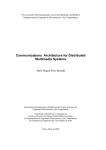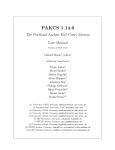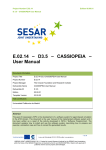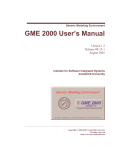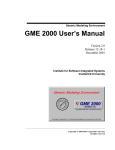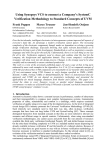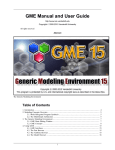Download C-SAW User`s Manual
Transcript
C-SAW User’s Manual
Version 1.0
Released January 2004
Yuehua Lin
Jeff Gray
Jing Zhang
September 2004
http://www.gray-area.org/Research/C-SAW
This project was previously funded by the DARPA
Program Composition for Embedded Systems (PCES)
program, and currently supported by the National Science
Foundation under CSR-SMA-0509342.
C-SAW Users Manual
2
Contents
1
INTRODUCTION ..................................................................................................... 4
1.1
OVERVIEW OF C-SAW.......................................................................................... 4
2
INSTALLATION ...................................................................................................... 6
2.1
INSTALLING GME ................................................................................................. 6
2.2
INSTALLING C-SAW ............................................................................................. 6
3
USING C-SAW .......................................................................................................... 9
3.1
INTRODUCTION ...................................................................................................... 9
3.2
STEP-BY-STEP GUIDE VIA A STATE MACHINE EXAMPLE ....................................... 9
4
THE EMBEDDED CONSTRAINT LANGUAGE............................................... 13
4.1
OVERVIEW .......................................................................................................... 13
4.2
TYPES AND OPERATORS ...................................................................................... 13
4.3
OPERATORS ON BASIC DATA TYPES ..................................................................... 14
4.4
OPERATORS ON OBJECT AND COLLECTION TYPES ................................................ 14
4.4.1
Model aggregation and selection................................................................ 14
4.4.2
Transformation operators........................................................................... 15
4.5
FUNCTION CALL EXPRESSIONS............................................................................. 15
4.6
ASPECT AND STRATEGY ...................................................................................... 16
4.7
LEARN TO WRITE ECL SPECIFICATIONS VIA AN EXAMPLE ................................. 16
5
APPENDIX 1: ECL BNF SPECIFICATION ....................................................... 20
6
APPENDIX 2: ECL FUNCTION INTERFACES................................................ 23
C-SAW Users Manual
3
1
Introduction
1.1 Overview of C-SAW
The Constraint-Specification Aspect Weaver (C-SAW) is a model-to-model
transformation engine that weaves crosscutting constraints or changes into domain
specific models automatically for rapid model construction and evolution. It is
implemented as a Plug-in component of Generic Modeling Environment (GME), which is
a meta-environment for constructing system and software models, developed by
Vanderbilt University.
C-SAW combines the ideas of Aspect-Oriented Software Development (AOSD) and
Model-Integrated Computing (MIC). MIC has been refined at Vanderbilt University over
the past decade to assist with creation and synthesis of computer-based systems. AspectOriented Software Development (AOSD) is a new model for software composition that
contributes to better separation of concerns and improved modularity of software.
Compared to other model transformation tools, C-SAW offers the ability to explore
numerous modeling scenarios by considering crosscutting modeling concerns as aspects
that can be rapidly inserted and removed from a model. This permits a modeler to make
changes more easily to the base model without manually visiting multiple locations in the
model.
GME is a toolkit for realizing the principles of MIC. It is a UML-based meta-modeling
environment that can be configured and adapted from meta-level specifications (called
the modeling paradigm) that describe the domain. When using the GME, a modeling
paradigm is loaded into the tool to define an environment containing all the modeling
elements and valid relationships that can be constructed in a specific domain. GME also
provides mechanisms for developing model interpreters, adds-on components and plug-in
components for various purposes. For example, a model interpreter can supply an ability
to generate other software artifacts (e.g., code or simulation scripts) from the models.
C-SAW is implemented as a Plug-in component of GME. An overview of model
transformation using C-SAW is depicted in Figure 1-1. As shown in the figure, model
transformation translates between source and target model(s), which can be instances of
the same meta-models. Transformation rules and application strategies are written in a
special language, called the Embedded Constraint Language (ECL), which is described in
details in Chapter 4. Typically, a transformation specification includes an aspect
specification and one or more strategy specifications. The aspect specification defines a
set of locations in the domain models; and strategy specifications describe the
transformation behaviors. The source model(s) and the transformation specification(s) are
interpreted by the transformation engine to generate the target model(s). All the
metamodels and models need to be built within GME.
Within C-SAW there includes an ECL parser and an interpreter for ECL to perform the
transformation by interacting with modeling APIs provided by GME. A C-SAW user
doesn’t need to know the internal parser and the interpreter, but need to provide the these
C-SAW Users Manual
4
inputs of C-SAW: source models and their metamodel built with GME and the
transformation specifications.
Figure 1-1
Additional information about C-SAW, including software downloads and video demos, is
available at: http://www.gray-area.org/Research/C-SAW.
C-SAW Users Manual
5
2 Installation
2.1 Installing GME
To use C-SAW, GME first needs to be installed on your computer. GME is available at
http://www.isis.vanderbilt.edu/Projects/gme/. Instructions on how to install and run GME
can be found on this website. C-SAW users should first become familiar with GME and
the basic GME GUI commands and interfaces. The sources models need to be
transformed by C-SAW should be built within GME in advance.
Different C-SAW versions are provided to support GME3-r4.11.10 or the above GME
versions. You need to choose the appropriate C-SAW version that supports the GME
version, with which you develop your models.
2.2 Installing C-SAW
The new weaver can be tied to any paradigm. Suppose you need to work on a GME
project, you install the C-SAW as follows.
Step 1:
• Download the C-SAW zip file from http://www.gray-area.org/Research/C-SAW/
• Unzip the C-SAW zip file to get the C-SAW component (e.g., called
Component.dll here)
Step 2:
• Launch GME and Open the GME project (mga file extension) using the “Open
Project…” option under the File menu
• Select the File Menu and then click on the register component command
Step 3:
• This brings up the Components dialog as shown in Figure 2-1.
• Click the installNew button; Go to the folder you stored the component.dll, select
component.dll
• Click “Open”
Step 4:
• You will go back to the Components dialog and the NewWeaver Plugin is already
on the list.
• Select it and click the Toggle button. See Figure 2-2.
C-SAW Users Manual
6
Figure 2-1
C-SAW Users Manual
7
Figure 2-2
Step 5:
• The C-SAW button on the GME tool bar, installation is done. See Figure 2-3.
The C-SAW icon
Figure 2-3
C-SAW Users Manual
8
3 Using C-SAW
3.1 Introduction
To use C-SAW to perform model transformations, first of all, you need to develop source
models in a GME project and write ECL transformation specifications that describe the
transformation task(s). After the source models and model transformation specifications
are developed, the following steps need to be taken when using C-SAW.
•
Open your GME project that contains your source models.
If the C-SAW icon is not visible on the GME toolbar, you need to register it within your
project (See Chapter 2 for installation details). If you open a model in GME, which is
called the focused model, is the default entry point of a model transformation, i.e., the
initial context where transformation starts. However, you can change the entry point by
specifying any target object explicitly in the aspect specification. For example, you can
specify the root folder or a collection of models as the initial transformation context.
•
Click the C-SAW icon on the GME toolbar, and follow the prompt to open your
specification file and then the specification is executed automatically by C-SAW.
After you finish executing a specification file, and you want to transform another one,
you need to close the project and then open it again before opening another specification
file.
3.2 Step-by-step Guide via a State Machine Example
This example shows how to modify an attribute of an ATM model, which is an instance
model of the state machine metamodel. In this scenario, the source model (as input to CSAW) is the ATM model; and the target model (as output of C-SAW) is the modified
ATM model. A simple ECL specification is developed to describe such a transformation.
C-SAW executes this specification to modify the attribute of the ATM model.
1. Open the project in GME that contains the ATM model.
If you also open the ATM model after opening the project, the open ATM model will be
the default entry point of the transformation unless you specify any other model(s) or
atoms explicitly by model querying. In this example, the open ATM model is implicitly
as the default entry point, from which the CardInserted atom is selected as the application
context of the ModifyAttr strategy. Originally, the text attribute of the CardInserted atom
is “Please Input Pin” as shown in Figure 3-1.
C-SAW Users Manual
9
Figure 3-1
2. Invoke the C-SAW engine.
Click on the C-SAW icon on the toolbar to invoke the C-SAW engine. If the icon is not
visible, you need to register it. After you click on the C-SAW icon, you can see the
prompt as shown in Figure 3-2 and then click ok.
Figure 3-2
C-SAW Users Manual
10
3. Open the specification file.
Go to the folder you store your specifications and select the specification file as shown on
Figure 3-3. The specification file is called modifyAttribute.spc, which is shown in Listing
3-1.
Figure 3-3
defines ModifyAttr, PickAState;
strategy ModifyAttr ( )
{
declare newText : string;
newText := "Please input your identification number";
setAttribute("Text", newText);
}
aspect PickAState()
{
atoms("State")->select(m|m.name() == "CardInserted")->ModifyAttr ( );
}
Listing 3-1
4. C-SAW executes the open specification file.
The original ATM model is modified by C-SAW by executing the specification. As
shown in Figure 3-4, the text attribute of the CardInsterted atom is changed to “Please
input your identification number”.
C-SAW Users Manual
11
Figure 3-4
C-SAW Users Manual
12
4 The Embedded Constraint Language (ECL)
4.1 Overview
The transformation language provided by C-SAW is a textual script-like language, called
the Embedded Constraint Language (ECL). The ECL is an extension of Object Constraint
Language (OCL), and provides many of the common features of OCL, such as arithmetic
operators, logical operators, and numerous operators on collections (e.g., size and select).
ECL also provides special operators to support model aggregates (e.g., models and
atoms), connections (e.g., source and destination) and transformations (e.g., addModel
and setAttribute). In general, ECL supports an imperative transformation procedural
style. In addition, by providing strategy and aspect constructs, ECL offers the ability to
explore numerous modeling scenarios by considering crosscutting modeling concerns as
aspects that can be rapidly inserted and removed from a model. This permits a model
engineer to make changes more easily to the base model without manually visiting
multiple locations.
4.2 Types and Operators
The data types in ECL include the basic data types (e.g., boolean, integer, real and string)
and the GME object types (e.g., atom, model, object and folder) as well as the GME
collection types (e.g., atomList, modelList, and objectList). This type set can be extended
according to further need. The data types are explicitly used in parameter definition and
local variable declaration of a strategy. The narrow type conversion is supported in
assignment statements. There are there GME types (i.e., set, reference and connection),
which are not explicitly supported in ECL. However, they can be considered as object
type. Table 4-1 is an overview of the ECL data types.
Table 4-1 An overview of data types.
Type Keyword
Description
boolean
A boolean can have only one of two values: true or false.
integer
The integer type represents the mathematical natural numbers.
real
The real type represents the mathematical concept of real values.
string
A string is a sequence of characters, written with enclosing double
quotes, e.g., “NewGateWay”.
atom
Equivalent to the atom type in GME
model
Equivalent to the model type in GME
atomList
A list of atoms.
modelList
A list of models.
object
Equivalent to the object type in GME
objectList
Equivalent to the object type in GME
folder
Equivalent to the folder type in GME
C-SAW Users Manual
13
For detailed information about these types, please reference the GME manual.
4.3 Operators on Basic Data Types
There are standard operators for the boolean, integer and real as well as string types,
which are described in the following tables.
Table 4-2 Standard operators for the boolean type.
Operator
Notation
or
a or b
and
a and b
exclusive or
a xor b
implies
a implies b
Result type
boolean
boolean
boolean
boolean
Table 4-3 Standard operators for the integer and real type.
Operator
Notation
equals
a == b
not equals
a <> b
less
a<b
more
a>b
less or equal
a <= b
more or equal
a >= b
plus
a+b
minus
a–b
multiplication
a*b
division
a/b
not
-a or not a
Result type
boolean
boolean
boolean
boolean
boolean
boolean
integer or real
integer or real
integer or real
real
integer or real
4.4 Operators on Object and Collection Types
The operators on object and collection types include two groups: one group is used to
querying objects and collections (including aggregation and selection operators), the
other group is used to alter the models and atoms (called transformation operators).
4.4.1 Model Aggregation and Selection
One common activity during model transformation is to find elements in a model. There
are two different approaches to locating model elements. The first approach - querying evaluates an expression over a model, returning those elements of the model for which
the expression holds. The other common approach uses pattern matching where a term or
a graph pattern containing free variables is matched against the model. Currently, ECL
supports model queries primarily by providing the select operator. Other operators
include model aggregation operators to select a collection of objects, and a set of
operators to find a single object.
C-SAW Users Manual
14
The select(expression) operator is frequently used in ECL to specify a selection from a
source collection and the result is always a subset of the original collection. In addition,
model aggregation operators can also be used to perform model querying. For example,
models(expression) is used to select all the submodels that satisfy the constraint specified
by the expression. Other aggregation operators include atoms(expression),
connections(expression), attributes(expression), source() and destination(). Specifically,
source() and destination() are used to return the source object and the destination object
in a connection. Another set of operators are used to obtain a single object (e.g., findAtom
and findModel). The following ECL code shows a number of operators just mentioned:
rootFolder().findFolder("ComponentTypes").models() ->
select(m|m.name().endWith("Impl")) ->AddConcurrency();
First, rootFolder returns the root folder of a modeling project. Next, findFolder is used to
return a folder named “ComponentTypes” under the root folder. Then, models() is used to
find all the models in the “ComponentTypes” folder. Finally, the select operator is used
to select all the models that match the predicate expression (i.e., those models whose
names end with “Impl”). The “AddConcurrency” strategy is then applied to the resulting
collection.
4.4.2 Transformation Operators
ECL provides basic transformation operations to add model elements remove model
elements and change properties of model elements. Standard OCL does not provide such
capabilities because it does not allow side effects on a model. However, a transformation
language should be able to alter the state of a model. ECL extends the standard OCL by
providing a series of operators for changing the structure or constraints of a model. To
add new elements (e.g., a model, atom or connection) to a model, ECL provides such
operators as addModel, addAtom and addConnection. Similarly, to remove a model, atom
or connection, there are operators like removeModel, removeAtom and
removeConnection. To change the value of any attribute of a model element, setAttribute
can be used.
4.5 Function Call Expressions
Operators on all the object and collection types define various behaviors to manipulate
GME models, which are also called ECL functions and used via function calls. There are
two kinds of function calls depending on the type of the caller: 1)
caller.functionName(parameters), and 2) caller->functionName(parameters). The former
using a dot means the caller is a single object (e.g., an atom, a model or an object); the
latter using an arrow means the caller is a set of objects(e.g., an atomList, a modelList or
an objectList). Parameters can be none, one or more. For example, the function call
"aModelInstance.atoms()" returns all the atoms of the model instance; and “aModelList>size()” return the number of the models in this model list. Thus, caller constitutes the
context of a function call.
When a caller is not specified explicitly, there still exists a default caller, which is the
rootModel of the currently focused paradigm; for example, a single statement "atoms();"
C-SAW Users Manual
15
will return all the atoms of the root model of currently open paradigm although there is
not any explicitly specified caller for it, thus it is equivalent to “self.atoms();” where self
is a keyword that represents the current focused model or atom.
According to all the functions currently supported, the valid caller type can be either an
atom/model/object or a list of them or a folder, depending on the definition of each
function. The usages and purpose of all the functions are describe in Appendix 2 where
some other predefined functions (e.g., show) and operators on string type (e.g., endWith)
are also included.
4.6 Aspect and Strategy
There are two kinds of modular constructs in ECL: strategy and aspect, which are
designed to provide aspect-oriented capabilities in specifying crosscutting modeling
concerns. A strategy is used to specify elements of computation and the application of
specific properties to the model entities (e.g., adding model elements). A modeling aspect
is used to specify a crosscutting concern across a model hierarchy (e.g., a collection of
model elements that across a model).
In general, an ECL specification may consist of one or more strategies, and a strategy can
be called by other strategies. A strategy call implements the binding and parameterization
of the strategy to specific model entities. The context of a strategy call can be an entire
project; a specific model, atom, or connection; or a collection of assembled modeling
elements that satisfy a predicate. The aspect construct in ECL is used to specify such a
context.
In a procedural style transformation, an aspect is the start point of a transformation
process. Currently, it doesn't support parameter binding, local variables definition and
assignment statements as a strategy does. Inside an aspect body, it is typically a statement
that calls a strategy. By default, this strategy is applied to the default entry point (e.g., the
currently open model in GME). If there is a querying statement preceded with the
strategy call, the strategy call will be applied to the querying result. For example,
“atoms()->select(m|m.name() == “LogOnWrite”).DoSomething();” the DoSomething()
strategy will be applied to the atom named “LogOnWrite”.
Usually, a strategy is called within an aspect. Additionally, a strategy can be called within
another strategy. Inside an aspect or a strategy, there should be at least one statement
(e.g., you can put a show statement to print out something). In other words, the body of
an aspect or a strategy can’t be blank, otherwise a syntactical error occurs.
4.7 Learn to Write ECL Specifications via an Example
Embedded System Modeling Language (ESML) is used to model real-time mission
computing embedded avionics applications. ESML provides the following modeling
categories to allow representation of an embedded system: 1) Components, 2)
Component Interactions, and 3) Component Configurations.
C-SAW Users Manual
16
Bold Stroke is a product-line architecture written in several million lines of C++ that was
developed by Boeing in to support families of mission computing avionics applications
for a variety of military aircraft. There are over 20 representative ESML models for all of
the Bold Stroke usage scenarios that have been defined by Boeing. For each specific
scenario within Bold Stroke, the components and their interactions via an event channel
are captured by ESML models. For example, the internal configuration of a component is
specified with data elements and event types as well as communication ports (e.g., the
facet/receptacle descriptors for communicating events). An example of transforming Bold
Stoke ESML models to support a black box data recorder is illustrated as below.
In avionics systems, an essential diagnostic tool for failure analysis is a “black box” that
records important flight information. This device can be recovered during a failure, and
can reveal valuable information even in the event of a total system loss. Currently, the
Bold Stroke ESML component models do not represent the black box flight recorder
concern. To add this concern to corresponding models, a log atom can be used to specify
different logging policy such as “Record the values upon <entry/exit> of <a set of named
methods>” or “Record the value upon every update to the <data variable>.” A model
transformation is needed to weave black box data recorder representations (i.e., the log
atoms in ESML) into these ESML component models. The requirement of this
transformation task can be briefly described as follows:
For all models which type is component,
Find all the data atoms,
For each data atom,
add a log atom and proper connection
Figure 4-1 shows an ESML component model without any log atom. To manually add
log atoms into over 20 existing component models will be time consuming and
susceptible to errors. C-SAW automates this transformation based on the ECL
transformation specification shown in Listing 4-1.
The above specification written in ECL supports the requirement “Log every time and in
every component that an update occurs on the data1 field”. The Start aspect selects all the
component models whose name ends with “Impl” in the ComponentTypes folder. The
FindData strategy finds all of the “Data” atoms in every component and then applies the
AddLog strategy on each of them. Inside the AddLog strategy, parentModel is the model
to which the data atom belongs. A new log atom is created in this model and set
“OnWrite” to its Kind attribute and the “MethodList” attribute as “Update”. Finally, it
connects this new “Log” atom to its corresponding “Data” atom. As a result, after using
C-SAW to apply this ECL specification, “LogOnWrite” atoms will be inserted into each
component that has a “Data” atom as shown in Figure 4-2.
C-SAW Users Manual
17
Figure 4-1
Figure 4-2
C-SAW Users Manual
18
strategy FindData1( ) {
atoms()->select(a | a.name() == "Data1")->AddLog();
}
strategy AddLog( ) {
declare parentModel : model;
declare dataAtom, logAtom : atom;
dataAtom := self();
parentModel := parent();
logAtom := parentModel.addAtom("Log", "LogOnWrite");
logAtom.setAttribute("Kind", "OnWrite");
logAtom.connectedTo(dataAtom);
}
aspect Start( ) {
rootFolder( ).findFolder("ComponentTypes").models()->FindData1();
}
Listing 4-1
C-SAW Users Manual
19
5 Appendix 1: ECL BNF Specification
name : id:IDENT;
defines : { DEFINES defs SEMI };
defs : def ( COMMA def )*;
def : name ;
cpars : cpar ( SEMI cpar )* ;
cpar : name ( COMMA name )* ":" name;
cdef : { INN foldername { DOT modelname { DOT aspectname }}} (STRATEGY name
| ASPECT name )
LPAR { cpars } RPAR
priority
description
LBRACE cexprs { action } RBRACE
| FUNCTION name LPAR { cpars } RPAR cexprs { action } ;
priority : PRIORITY "=" id:INTEGER | ;
description : id:STR | ;
foldername : name ;
modelname : name ;
aspectname : name ;
lval : name;
astring : str:ACTION ;
action : astring;
cexprs : cexpr SEMI ( cexpr SEMI )* ;
cexpr : { action } ( assign | DECLARE STATIC cpar
| DECLARE cpar
| lexpr) ;
assign : lval ASSIGN lexpr ;
C-SAW Users Manual
20
ifexpr : IF cexpr
THEN cexprs { action }
{ ELSE cexprs { action } }
ENDIF;
lexpr : relexpr lexpr_r ;
lexpr_r : { lop relexpr lexpr_r }
;
relexpr : addexpr { rop addexpr }
;
addexpr
: mulexpr addexpr_r ;
addexpr_r :{ addop mulexpr addexpr_r } ;
mulexpr
: unaexpr mulexpr_r ;
mulexpr_r :{ mulop unaexpr mulexpr_r
}
;
unaexpr
: ( unaryop postfixexpr ) | postfixexpr
postfixexpr:
primexpr postfixcall ;
postfixcall :
{ ( ( DOT | ARROW | CARET ) call ) postfixcall }
primexpr : litcoll | lit |
;
;
objname callpars | LPAR cexpr RPAR | ifexpr ;
callpars : { LPAR ( ( decl ) ? decl { actparlist } | { actparlist } ) RPAR } ;
lit
:
string | number ;
tname : name ;
litcoll : coll LBRACE { cexprlrange } RBRACE ;
cexprlrange : cexpr { ( (COMMA cexpr )+ ) | ( ".." cexpr ) }
;
call : name callpars ;
decl
:
name
objname
:
actparlist : cexpr
( COMMA name )*
{ ":" tname } "\|" ;
name | SELF ;
( COMMA cexpr )*
C-SAW Users Manual
;
21
lop
: AND | OR | XOR | IMPLIES
;
coll : SET | BAG | SEQUENCE | COLLECTION
rop
: "==" | "<" | ">" | ">=" | "<=" |
addop > :
"<>"
;
;
PLUS | MINUS ;
mulop > : MUL | DIV ;
unaryop :
string :
number :
MINUS | NOT
;
str:STR ;
r:REAL | n:INTEGER
;
}
#token STR
#token INTEGER
#token REAL
#token IDENT
C-SAW Users Manual
"\"~[\"]*\""
"[0-9]+"
"([0-9]+.[0-9]* | [0-9]*.[0-9]+) {[eE]{[\-\+]}[0-9]+}"
"[a-zA-Z][a-zA-Z0-9_]*"
22
6 Appendix 2: ECL Function Interfaces
name
purpose: return a caller's name
caller: an atom, a model or an object
usage:caller.name().
result type: string
kindOf
purpose: return an caller's kindname.
caller: an atom, a model or an object
usage:caller.kindOf().
result type: string
size
purpose: return the size of the caller list.
caller: atomList, modelList or an objectList.
usage:caller.size().
result type: int
isNull
purpose: determine if the caller is null.
caller: an atom, a model or an object
usage:caller.isNull().
result type: boolean
models
purpose: return all the models or the models with specific kindName within
a caller.
caller : a model or a folder.
usage:caller.models() or caller.models(string kindName).
result type: modelList
modelRefs
purpose: return all the models within a caller that are referred by the model
references with the specific kindName.
caller: a model or an object that represents a model.
usage: caller.modelRefs(string kindName).
result type: modelList
atoms
purpose: return all the atoms or the atoms with specific kindName within a caller.
caller: a model or an object that represents a model.
usage:caller.atoms() or caller.atoms(string kindName).
result type: atomList.
C-SAW Users Manual
23
select
purpose: select the atoms or the models within a caller according to the specified
condition.
caller: atomList, modelList or an objectList
usage:caller.select(logic expression);
for example, atoms("")->select(m|m.kindOf() == "State").
result type: atomList or modelList.
parent
purpose: return the parent model of a caller.
caller: a model, an atom or an object that represents a model/an atom.
usage: caller.parent()
result type: model
refersTo
purpose: return a model/an atom/an object that the caller refers to.
caller: a modelRef or an object that represents a model reference.
usage: caller.referesTo( )
result type: model or atom or object
connections
purpose: return all the connections with a specific connection kindname within a
model.
caller: a model or an object that represents a model.
usage: caller.connections(string connName)
result type: objectList that represents a list of connections.
destination
purpose: return the destination point of a connection.
caller: a connection.
usage: caller.destination().
result type: model/atom/reference/object
source
purpose: return the source point of a connection.
caller: a connection.
usage: caller.source().
result type: model/atom/reference/object
addConnection
purpose: add a connection with a specific kindName from a source object to a
destination object within a caller..
caller: a model or an object that represents a model.
usage: caller.addConnection(string kindName, object source, object destination)
result type: connection
C-SAW Users Manual
24
findConnection
purpose: find a connection with a specific kindName from a source object to a
destination object within a caller..
caller: a model or an object that represents a model.
usage: caller.findConnection(string kindName, object source, object destination)
result type: connection
removeConnection
purpose: remove a connection with a specific kindName from a source object to a
destination object within a caller..
caller: a model or an object that represents a model.
usage: caller.removeConnection(string kindName, object source, object
destination)
result type: void
rootFolder
purpose: return the root folder of an open GME project.
caller: none.
usage: rootFolder()
result type: folder
findFolder
purpose: return a folder with a specific name.
caller: a folder.
usage: caller.findFolder(string folderName)
result type: folder
addFolder
purpose: add a folder based on its kindName and assign a new name to it.
caller: a folder
usage: caller.addFolder(string kindName, string newName)
result type: folder
addSet
purpose: add a set based on its kindName and assign a new name to it within a
caller or a list of callers.
caller: a model or a list of models.
usage: caller.addSet(string kindName, string newName) or caller->addSet(string
kindName, string newName)
result type: set
C-SAW Users Manual
25
addMember
purpose: add an object as a member of a set.
caller: an object that represents a set.
usage: caller.addMember(object anObj)
result type: void
addReference
purpose: add a reference with a specific kindName that refers to an object and
assign a new name to it within a caller.
caller: a model.
usage: caller.addReference(string kindName, object refTo)
result type: reference
findAtom
purpose: return an atom based on its name within a caller.
caller: a model or an object that represents a model.
usage: caller.findAtom(string atomName)
result type: atom
addAtom
purpose: add an atom based on its partName(i.e., kindName) that belongs to a
model and assign a new name to it.
caller: a model or an object that represents a model.
usage: caller.addAtom(string partName, string newName)
result type: atom
removeAtom
purpose: remove an atom based on its name.
caller: a model or an object that represents a model, which is the parent model of
the to-be-removed atom.
usage: caller.removeAtom(string atomName)
result type: void
addModel
purpose: add a model based on its partName(i.e., kindName) that belongs to a
model and assign a new name to it.
caller: a model, a folder, an object that represents a model/folder or a list of
models.
usage:
1) if caller is a single object, caller.addModel(string partName, string newName);
2) if caller is a list, caller-> addModel(string partName, string newName)
result type: model
findModel
purpose: return a model based on its name.
caller: a folder or a model or an object that represents a model.
C-SAW Users Manual
26
usage: caller.findModel(string modelName)
result type: model
removeModel
purpose: remove a model based on its name.
caller: a model or an object that represents a model, which is the parent model of
the to-be-removed model.
usage: caller.removeModel(string modelName)
result type: void
findObject
purpose: return an object based on its name within a caller.
caller: a model or a folder, or an object that represents a model/folder.
usage: caller.findObject(string objName)
result type: object
getAttribute
purpose: return the value of an attribute of a caller which type is int, double or
string.
caller: an atom, a model or an object.
usage: caller.getAttribute(attrName)
result type: int, double or string
intToString
purpose: convert an integer value to string
caller: none.
usage: intToString(int val)
result type: string
setAttribute
purpose: set a new value to an attribute of a caller
caller: an atom, a model or an object.
usage: caller.setAttribute(string attrName, anyType value)
result type: void
show
purpose: display string message
caller: none
usage: show(any expression that returns a string)
result type: void
endWith
purpose: check if a string ends with a substring
caller: a string
usage: caller.endWith(string aSubString)
result type: boolean.
C-SAW Users Manual
27
Notes:
1) Any find operation (e.g., findAtom, findModel, findConnection) will return
null if it can not find the atom or model or connection.
2) Combination of a find operation and isNull operation can be used to determine
whether a model/atom/connection exists or not.
C-SAW Users Manual
28




























